Dynforce Archwire
-
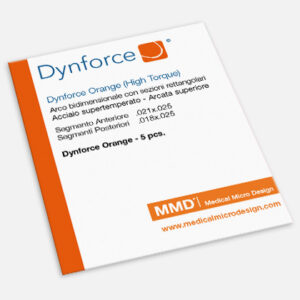 Order the Dynforce archwire
Order the Dynforce archwireDynforce Orange (High Torque Control)
Features:- Anterior segment .021x.025
- Posterior segments .018x.025
- Upper: 34 mm (lateral to lateral)
- Lower: 32 mm (canine to canine)
-
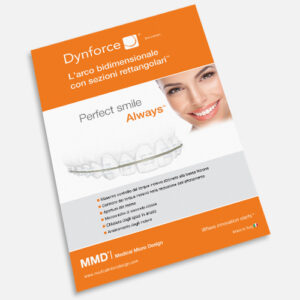 Download free
Download freeDynforce Two-Dimensional Archwire Clinical Manual
- explanatory clinical cases
- Dynforce usage technique
Dynforce patented
patented
The bidimensional archwire with rectangular cross sections™
- Total control of incisor torque combined with low friction sliding mechanics
- Control of incisor torque during the alignment of crowded arches
- Opening of the bite
- Class II mechanics
- Space closure
- Incisor retraction
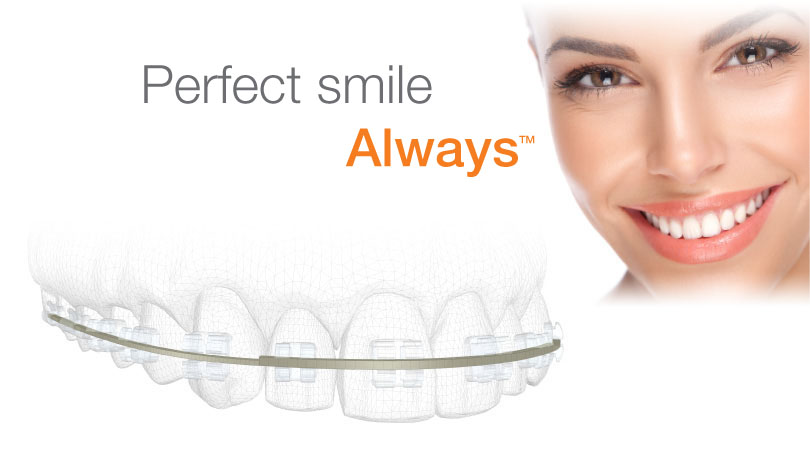
Medical Micro Design presents the Dynforce bidimensional archwire, highest expression of the technological innovation in the field of orthodontic archwires.The exclusive technology of Medical Micro Design was able to create a bidimensional archwire with edgewise rectangular cross sections that allows the maximum control of incisor torque in every clinical situation combined with the low friction on posterior teeth.Dynforce is the ideal archwire to use in the working and finishing phases, for the precision in incisor alignment and torque expression and for the simplicity of use.
The Dynforce bidimensional archwire is able to give the correct torque and alignment to the incisors, making the working and finishing phases very simple in different clinical situations like:
- Correction of crowding
- Opening of the bite
- Class II mechanics
- Midline shift correction
- Space closure
- Incisor retraction
- Expansion of the dental arch in crowded cases
Technical features
The Dynforce bidimensional archwire presents a .021x.025 full sized anterior segment and .018x.025 undersized posterior segments.
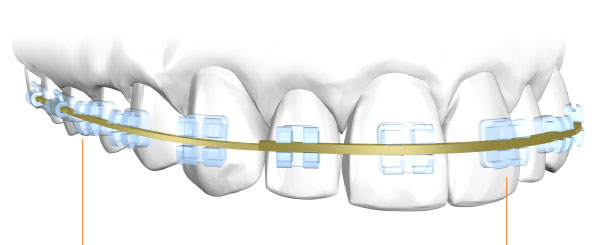
 Posterior segments with size .018x.025:
Posterior segments with size .018x.025:
Low friction on canine, premolars, molars
Posterior segments have size .018x.025 and occupy the slot of canines, premolars, molars. Posterior segments have a lower coefficient of binding, and allow an easy insertion and removal of the archwire, without generating patient discomfort. This reduces the chair time needed for the insertion, removal and activation of the archwire.
The low coefficient of binding allows low friction sliding mechanics, improving the efficiency of orthodontic treatments.
Further, the vertical clearance between archwire and bracket slot allows easy settling of the occlusion during the finishing phase.
 Anterior segment with size .021x.025:
Anterior segment with size .021x.025:
Maximum control of incisor torque
The .021x.025 anterior segment is full sized and occupies the slot of the central and lateral incisors. It allows to reduce the wire-bracket play to only 5°-6° (1), and guarantees a perfect expression of incisor torque starting from the first months of treatment.
Edgewise rectangular cross sections,
for a total control of arch form,
rotations, in-out.

The design of the Dynforce bidimensional archwire presents edgewise rectangular cross sections in the .021x.025 anterior segment and in the .018x.025 posterior segments.
The rectangular cross section allows the archwire to fill the horizontal dimension of the bracket slot (.028) by a larger extent, for a total control of arch form, dental rotations and in-out.
The Dynforce bidimensional archwire utilizes rectangular cross sections and not round, because the round cross section doesn’ t fill the slot in its horizontal dimension, generating a poor control of rotations, arch form and in-out. Further, the lack of torque control of the round wire makes it not suitable for space closure mechanics.
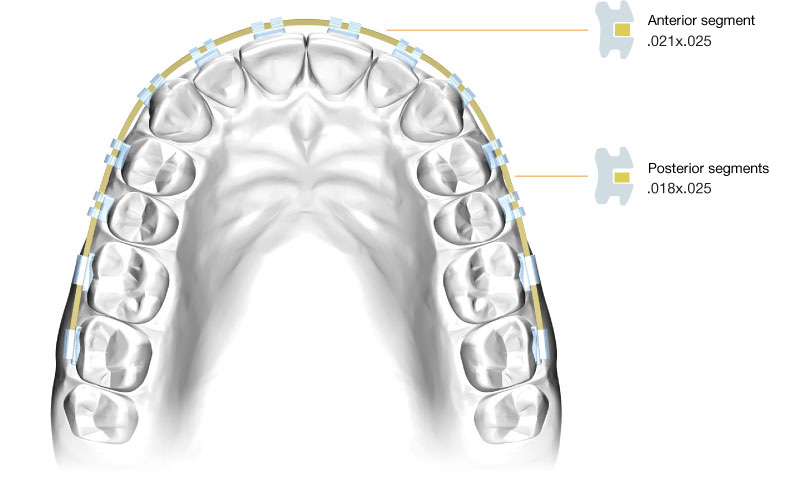
The design of the Dynforce bidimensional archwire
with edgewise rectangular cross sections
is the result of years of research and clinical trials
and is an exclusive of Medical Micro Design.
The Dynforce bidimensional archwire presents a .021x.025 full sized anterior segment and .018x.025 undersized posterior segments.

 Posterior segments with size .018x.025:
Posterior segments with size .018x.025:
Low friction on canine, premolars, molars
Posterior segments have size .018x.025 and occupy the slot of canines, premolars, molars. Posterior segments have a lower coefficient of binding, and allow an easy insertion and removal of the archwire, without generating patient discomfort. This reduces the chair time needed for the insertion, removal and activation of the archwire.
The low coefficient of binding allows low friction sliding mechanics, improving the efficiency of orthodontic treatments.
Further, the vertical clearance between archwire and bracket slot allows easy settling of the occlusion during the finishing phase.
 Anterior segment with size .021x.025:
Anterior segment with size .021x.025:
Maximum control of incisor torque
The .021x.025 anterior segment is full sized and occupies the slot of the central and lateral incisors. It allows to reduce the wire-bracket play to only 5°-6° (1), and guarantees a perfect expression of incisor torque starting from the first months of treatment.
Edgewise rectangular cross sections,
for a total control of arch form,
rotations, in-out.

The design of the Dynforce bidimensional archwire presents edgewise rectangular cross sections in the .021x.025 anterior segment and in the .018x.025 posterior segments.
The rectangular cross section allows the archwire to fill the horizontal dimension of the bracket slot (.028) by a larger extent, for a total control of arch form, dental rotations and in-out.
The Dynforce bidimensional archwire utilizes rectangular cross sections and not round, because the round cross section doesn’ t fill the slot in its horizontal dimension, generating a poor control of rotations, arch form and in-out. Further, the lack of torque control of the round wire makes it not suitable for space closure mechanics.

The design of the Dynforce bidimensional archwire
with edgewise rectangular cross sections
is the result of years of research and clinical trials
and is an exclusive of Medical Micro Design.
The advantages of the Dynforce archwire
Foreword
Most orthodontic techniques use a .019x.025 archwire for the working phase of treatment.
The .019x.025 archwire has a play of 12-15° in the .022 slot (1,2); clinically this play generates several problems when teeth erupt in ectopic position, or in the presence of mechanics that move incisors in a distal or mesial direction.
The problem of ectopic eruption
The crowns of teeth that erupt in an ectopic position are aligned during the aligning phase, however the roots are not moved because of the excessive play between the archwire and the bracket. The result is a wrong inclination of teeth associated with misalignment of the incisal margins. Clinically a proclined tooth appears shorter and with the incisal margin in a buccal position, while a retroclined tooth appears longer and with the incisal margin in a palatal position.
For example, two central incisors that erupt in different positions, can have up to 15-20° of difference in their inclination if a .019x.025 archwire is utilized.
.019x.025 archwire
Dynforce bidimensional archwire
Teeth erupted in ectopic position. Up to 20° of difference in their inclination can exist if an undersized archwire is utilized.
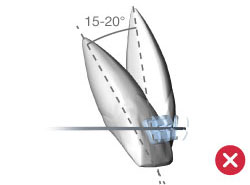
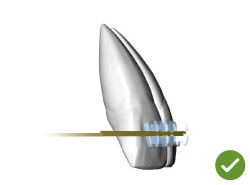
Difference on the vertical plane (length of tooth and overbite) between a proclined and a retroclined tooth.
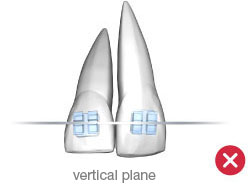
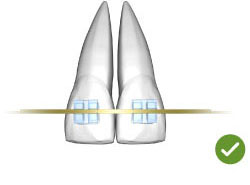
Difference on the horizontal plane (in-out) between a proclined and a retroclined tooth.
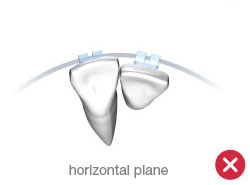
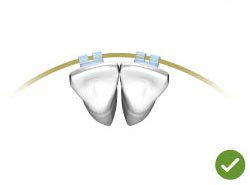
The Dynforce bidimensional archwire, thanks to the .021x.025 full sized anterior segment generates a correct torque and properly aligns the incisal margins in the vertical and horizontal planes.
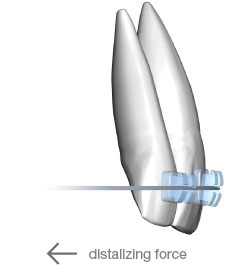
The problem of distalizing mechanics and loss of incisor torque
Distalizing forces on incisors are generated by Class II elastics, fixed functional appliances, mechanics of space closure.
In these clinical situations the presence of excessive play between archwire and slot causes the loss of incisor torque. Incisors become more upright and overbite increases.
The Dynforce bidimensional archwire, thanks to the .021x.025 full sized anterior segment, prevents the loss of incisor torque.
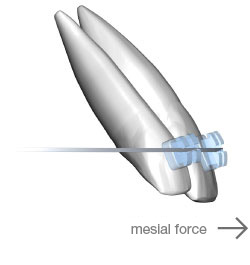
The problem of mesial forces and proclination of incisors
In crowded cases teeth unravel during the alignment phase, moving to a larger circumference. Teeth are subject to a force directed buccally that pushes incisors forward. Incisors become more proclined and overbite is reduced.
The Dynforce bidimensional archwire, thanks to the reduced wire-bracket play (only 5°) of the .021x.025 anterior segment prevents the proclination of the incisors.
References
1-2 Medical Micro Design internal data
Foreword
Most orthodontic techniques use a .019x.025 archwire for the working phase of treatment.
The .019x.025 archwire has a play of 12-15° in the .022 slot (1,2); clinically this play generates several problems when teeth erupt in ectopic position, or in the presence of mechanics that move incisors in a distal or mesial direction.
The problem of ectopic eruption
The crowns of teeth that erupt in an ectopic position are aligned during the aligning phase, however the roots are not moved because of the excessive play between the archwire and the bracket. The result is a wrong inclination of teeth associated with misalignment of the incisal margins. Clinically a proclined tooth appears shorter and with the incisal margin in a buccal position, while a retroclined tooth appears longer and with the incisal margin in a palatal position.
For example, two central incisors that erupt in different positions, can have up to 15-20° of difference in their inclination if a .019x.025 archwire is utilized.
.019x.025 archwire
Dynforce bidimensional archwire
Teeth erupted in ectopic position. Up to 20° of difference in their inclination can exist if an undersized archwire is utilized.


Difference on the vertical plane (length of tooth and overbite) between a proclined and a retroclined tooth.


Difference on the horizontal plane (in-out) between a proclined and a retroclined tooth.


The Dynforce bidimensional archwire, thanks to the .021x.025 full sized anterior segment generates a correct torque and properly aligns the incisal margins in the vertical and horizontal planes.

The problem of distalizing mechanics and loss of incisor torque
Distalizing forces on incisors are generated by Class II elastics, fixed functional appliances, mechanics of space closure.
In these clinical situations the presence of excessive play between archwire and slot causes the loss of incisor torque. Incisors become more upright and overbite increases.
The Dynforce bidimensional archwire, thanks to the .021x.025 full sized anterior segment, prevents the loss of incisor torque.
The problem of mesial forces and proclination of incisors
In crowded cases teeth unravel during the alignment phase, moving to a larger circumference. Teeth are subject to a force directed buccally that pushes incisors forward. Incisors become more proclined and overbite is reduced.
The Dynforce bidimensional archwire, thanks to the reduced wire-bracket play (only 5°) of the .021x.025 anterior segment prevents the proclination of the incisors.
References
1-2 Medical Micro Design internal data

